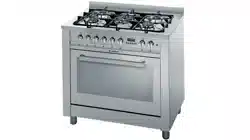Loading ...
Loading ...
Loading ...

9
The following instructions are provided for qualified installers
so that they may accomplish installation, adjustment and
technical maintenance operations correctly and in
compliance with national current regulations and standards.
Important: the appliance should be disconnected from
the mains electricity supply before any adjustment,
maintenance, etc. is carried out. Maximum caution should
be exercised should it be necessary to keep the appliance
connected to the electricity supply.
The cookers have the following technical specifications:
Cat. II2H3+
The maximum dimensions of the appliance are given in the
figure on page 2. For trouble-free operation of appliances
installed in housing units, the minimum distances shown in
fig.8 should be observed. Adjacent surfaces and the wall at
the rear should also be able to withstand a temperature of
65 °C
Prior to installing the cooker, 99 ÷ 155 mm high supporting
feet (provided) should be fitted into the holes to be found in
the bottom of the cooker (fig.9). These feet are screw-
adjustable and whenever necessary should be used to make
sure the cooker stands level.
Positioning
This appliance may only be installed and operated in
permanently ventilated rooms in compliance with provisions
laid down by current regulations and standards. The following
requirements must be observed:
• The appliance must discharge combustion products into a
special hood, which must be connected to a chimney, flue
pipe or directly to the outside (fig.10).
• If it is impossible to fit a hood, the use of an electric fan is
permitted, either installed on a window or on an external
wall, which must be switched on at the same time as the
appliance.
INSTRUCTIONS FOR THE INSTALLER
In a chimney stack or branched flue Directly to the outside
(exclusively for cooking appliances)
Kitchen ventilation
The air flow into the room where the appliance is installed
must be equal to the quantity of air that is required for regular
combustion of the gas and for ventilating the same room.
Air must be taken in naturally through permanent apertures
made in the outside walls of the room or through single or
branching collective ventilation ducts in compliance with the
standards in force. The air must be taken directly from the
outside, from an area far from sources of pollution. The
ventilation aperture must have the following characteristics
(fig.11A):
• total free cross section of passage of at least 6 cm² for
every kW of rated heating capacity of the appliance, with
a minimum of 100 cm² (the heating capacity is indicated
on the rating plate);
• it must be made in such a way that the aperture cannot be
obstructed both on the inside and outside of the wall;
• it must be protected, e.g. with grills, wire mesh, etc. in
such a way that the above-mentioned free section is not
reduced;
• it must be situated as near to floor level as possible.
Detail A Adjacent Room to be
room ventilated
A
Examples of ventilation holes Enlarging the ventilation slot
for comburant air between window and floor
fig. 11A fig.11B
The air inflow may also be obtained from an adjoining room,
provided the latter is not a bedroom or a room where there
is a risk of fire, such as warehouses, garages, fuel stores,
etc. and is ventilated in compliance with the standards in
force. Air from the adjoining room to the one to be ventilated
may be made to pass freely through permanent apertures
with a cross section at least equal to that indicated above.
These apertures may also be obtained by increasing the
gap between the door and the floor (fig.11B). If an electric
fan is used for extracting the combustion products, the
ventilation aperture must be increased in relation to its
maximum performance. The electric fan should have a
fig.9
fig.10
fig.8
min. 50mm
min. 700mm
Class 1 Class 2 sub-class 1
Loading ...
Loading ...
Loading ...
